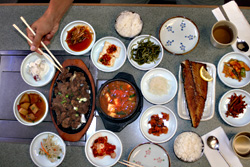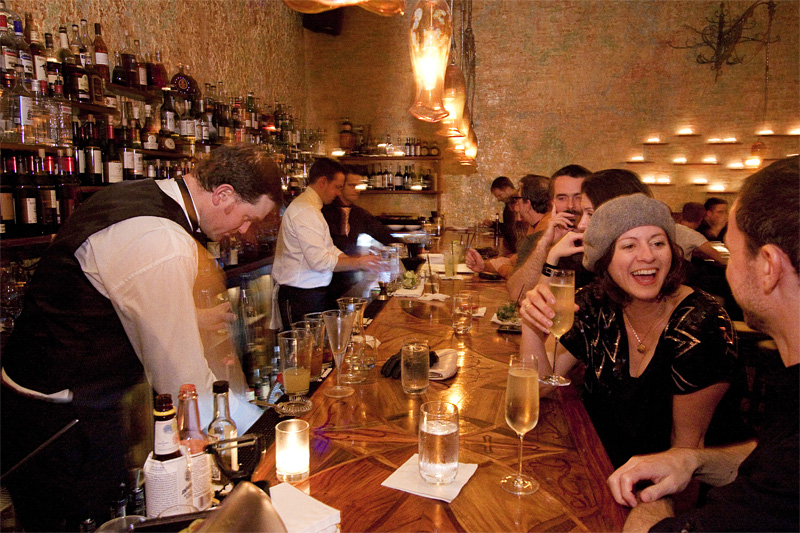It’s the era of $4-per-gallon gas, bikers’ rights/riots, and Hummer schadenfreude. The phrase “food miles” applies not only to New Zealand apples and Panamanian coffee but to the distance between fridge and supermarket. Telling friends you want to plant a victory garden to reduce your gas consumption no longer brands you a quixotic liberal.
But when it comes to Korean cuisine, toss that idealism out the window and jump in the car.
That’s because, beyond a few inner-city spots for solid everyday fare, the prospect of eyebrow-curling, palate-stoking Korean food means a drive to Edmonds-Lynnwood or Federal Way, the two centers of the Puget Sound’s growing Korean community. While your average Korean restaurant in Seattle or Bellevue has to pull a greatest-hits act to satisfy a mixed crowd of insiders and outsiders, Koreatown North and Koreatown South are big enough to sustain a supermarket war (Pal-Do World versus H-Mart), as well as restaurants specializing in live sushi, soft-tofu stew, fried chicken, and offal. Even the generalist restaurants are known for certain dishes—Ka Won for black-pig belly and a puffy baked omelet, Hae-Nam Kalbi & Calamari for Seoul-style squid and pork stew simmered at the table.
Two recent meals at tiny Chang Ahn Jung, whose reputation has barely spread beyond Korean foodies, reminded me that the 50-mile trek to Federal Way and back is not a peak-oil luxury I’m prepared to give up. Is it the fact that this bare-bones restaurant, which has five barbecue tables with hoods, nappy carpet, cinder-block walls, and a Technicolor poster of two dolphins jumping out of the water, serves cabbage kimchi so correct that I downed two bowls of it? (The fermented leaves had a prickly, pin-sharp tang and a clean-smelling funk fleshed out with green onions, instead of the saucy, more diffusely sour kimchi that all the north-of-Seattle restaurants serve.) Is it curiosity about Chang Ahn Jung’s long list of junggol (cook-at-the-table stews), which I want to try once fall’s cold rains begin?
Or was it the simple satisfaction of actually finding the tiny restaurant? It’s hidden among a row of strip malls along Pacific Highway, not that far south of South 320th Street, that houses offices and Cockatoo’s Chicken Restaurant. And by “hidden” I mean “practically a speakeasy,” because the restaurant transliterates the Hangul characters of its name as “Chang Ahn Jung” on the menu but “Jang-An” on the sign out front.
Though their brusqueness is good-natured, and they come to the table every time you press the doorbell on the wall, the servers are far from fluent in English. “What’s in the Chang Ahn dinner special?” I asked on one visit, pointing to item #1 in the “house specialties” column of the thick bound menu. The question flustered the waitress so much she asked a customer to translate for me. He described the special as a set meal including spicy pork, some kind of fish, and daenjang chigae, or a hot miso-like soup. At $33 for three dishes and eight to 10 side dishes, we chanced it.
My three friends and I added a few extra dishes to the introductory special because we’d forgotten the cardinal maxim—you will always eat too much at a Korean restaurant, no matter how many things you order. And when all of the plates finally arrived at the table, they reminded me that this is perhaps the world’s most colorful cuisine. All good American chefs have an eye for composition, and Chinese cooks certainly put out a rainbow spread, but they can’t compete with the sight of a table covered in little white bowls of banchan, the tiny side dishes that make up the best part of a meal at Chang Ahn Jung: the vivid green of Japanese cucumbers and scallion, covered in thick red chile paste. Chartreuse squash coins flecked with crimson. The violent red of cabbage kimchi and its sister, fermented daikon pickle. The snowy color of mayonnaise-coated macaroni salad or blanched potato threads tossed with a little sesame oil. The deep green of seaweed. The chocolate brown of potato chunks cooked in a soy-caramel sauce and slabs of sweet fish cake. Hot-dog chunks coated in golden, eggy halos (You think hot-dog fritters are surreal? Order the restaurant’s budae chigae, or hot-dog stew, a post–Korean War invention). Even though we knew five main dishes were coming, we couldn’t resist clearing the bowls, which the server then came around and refilled: a sure challenge to our gluttonous capabilities.
The combination dinner was remarkable not for the bulgogi—long curls of thinly sliced beef marinated in sweet soy and grilled by the kitchen—or the grainy, forbiddingly red soybean soup boiling over its oven-hot stone bowl, each chile-spiked sip producing an endorphin rush. It was the “grilled” mackerel, sheared in half right along the spine and then lightly dusted with flour and fried. This is a fish dish I’ve eaten at a dozen Korean restaurants, but never enjoyed half as much: Underneath the crackly, papery skin we picked out the butteriest of flesh, anointed with just a little lemon juice. By the end of the meal one of my friends was sucking the last of the meat off the pinbones. Considering the number of people each year who end up in emergency rooms with bones lodged in their gullets, this qualified as a death-defying act of gourmandism.
Most of the parties around us were grilling fresh pork belly, short ribs, and spicy pork over the grates in the center of the table (you have to order at least two kinds of meat for the waiters to turn on the flames). And the galbi I had ordered on my previous visit, caramelized and blackened, would rank with the short ribs at my favorite North End restaurants. But all the dishes that made the biggest impression at Chang Ahn Jung were seafood dishes.
Biggest isn’t always best: In one case, the impression was awful, which was partly my fault. I’m so used to pooh-poohing protesting waitresses at Asian restaurants that I insisted of course we’d love the cold noodles with chile sauce and marinated raw skate. Had I done my research beforehand, I’d have learned that raw skate is often marinated a few days to ripen its chlorine-rank stench. (On another hot evening I enjoyed the spongy buckwheat noodles without the skate, in a tangy, clear broth chilled with ice cubes.)
Two other seafood dishes stood out for all the right reasons. The first, a very popular seafood pancake the size and thickness of a doormat, bound woven-together scallions, shrimp, and tender squid with an eggy batter, which puffed and crisped in the pan before the squid toughened, a skillful act that few restaurants here have mastered quite so surely. And another item from the restaurant’s house-specialties list, the laconically titled boiled sablefish, was the most luxurious dish I’ve eaten since a glorious pork-belly rampage I went on at Lynnwood’s Ka Won this spring: Thick steaks of black cod were simmered in a broth thickened with kochujang, or sweet chile paste, and that red sauce saturated the moist fatty fish, huge squares of tofu, and brown slabs of caramelized turnip underneath. Considering the fact that my 1994 stick-shift Honda Accord gets 31 mpg on the highway, the cod was worth every penny of the $8 I’d spent traveling to eat it.
PRICE CHECK
Special dinner: $32.99
Boiled sablefish: $19.99
Seafood pancake: $12.99
Cold noodles (sans skate): $7.99






